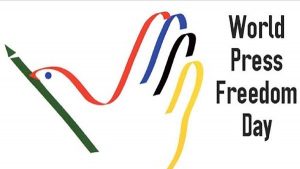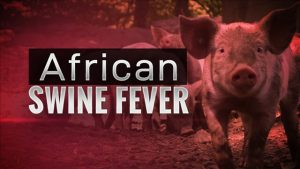Table of Contents
Daily Current Affairs for Government Exams:
Today Current Affairs:4th May 2020 for UPSC IAS exams, State PSC exams, SSC CGL, State SSC, RRB, Railways, Banking Exam & IBPS, etc
Contents:
- World Press Freedom Day..
- One-dimensional fluid simulation code
- Bioterrorism or Biological Attack
- ‘Bharatmarket’:
- BoBBLE.(Bay of Bengal Boundary Layer Experiment):
- .Non-Aligned Movement (NAM):
- African Swine Fever in Assam
- ‘Destination- Sariska Tiger reserve
- Other important current affairs
1.World Press Freedom Day :

The 27th celebration of World Press Freedom Day was organized by UNESCO.
- World Press Freedom Day was proclaimed by the UN General Assembly in December 1993, following the recommendation of UNESCO’s General Conference.
- Since then, 3 May, the anniversary of the Declaration of Windhoek is celebrated worldwide as World Press Freedom Day.
- The objective of the Day: To celebrate the fundamental principles of press freedom, assess the state of press freedom throughout the world, defend the media from attacks on their independence, and pay tribute to journalists who have lost their lives in the line of duty.
- The Prize honors a person or institution that contributed to the freedom of the press, esp. in the face of danger.
- The Prize was established on the initiative of UNESCO’s Executive Board and is formally conferred by the Director-General of the Organization.
- The prize, created in 1997, is awarded each year on the occasion of World Press Freedom Day on 3 May.
- Cash Prize: $25000 Prize.
Press freedom index
- The latest survey of Reporters Without Borders shows India dropping two places on the global Press freedom index ranking to 142nd on the list of 180 countries. Bhutan, Nepal, and Sri Lanka are ranked higher.
- Norway tops the Index for the fourth year in a row in 2020, while Finland is again the runner-up.
- North Korea (down 1 at 180th) has taken the last position from Turkmenistan, while Eritrea (178th) continues to be Africa’s worst-ranked country.
- The report “The World Press Freedom Index 2020” said that with no murders of journalists in India in 2019, as against six in 2018, the security situation for the country’s media might seem, on the face of it, to have improved.
2.One-dimensional fluid simulation code :

Scientists at the Indian Institute of Geomagnetism (IIG) have developed a generalized one-dimensional fluid simulation code capable of studying a wide spectrum of coherent electric field structures in near-earth plasma environments or earth’s magnetosphere.
- The developed simulation code is expected to help in the planning of future space missions.
Formation of Earth’s Magnetosphere:
- Sun is the major source of plasma deposition in space around the Earth.
- Thus, the Sun forces some of its plasma towards the earth in the form of the solar wind.
- Plasma is the most common state of matter in the universe as a whole.
- It consists of a gas of ions and free electrons.
- The speed of solar wind varies between 300 to 1500 km/s, which carries with it a solar magnetic field, called the Interplanetary Magnetic Field (IMF).
- The interaction of the IMF with the earth’s magnetic field creates the magnetosphere of the earth.
- The magnetosphere shields our home planet from solar and cosmic particle radiation, as well as erosion of the atmosphere by the solar wind – the constant flow of charged particles streaming off the sun.
3.Bioterrorism or Biological Attack::

The Covid-19 pandemic has exposed the vulnerability of several world powers in the event of the use of biological weapons against them by rogue states and terrorist groups.
- The United States, Britain, and the Soviet Union were involved in developing complex biological weapons programs after World War II and several nations continue to do so currently as well.
Bioterrorism or Biological Attack:
- It is the intentional release of viruses, bacteria, or other germs that can sicken or kill people, livestock, or crops.
Biological Weapons:
- They use microorganisms and natural toxins to produce disease in humans, animals, or plants.
- Biological weapons can be derived from bacteria, viruses, rickettsia, biological toxins and fungi.
- These agents can be deployed as biological weapons when paired with a delivery system, such as a missile or aerosol device.
- Bacillus anthracis, the bacteria that causes anthrax, is one of the most likely agents to be used in a biological attack.
- The most destructive bioterrorism scenario is the airborne dispersion of pathogens over a major population region.
- Tropical agricultural pathogens or pests can be used as anticrop agents to hamper food security worldwide.
- It is a substantial threat because small amounts of biotic agents can be effortlessly hidden, transported, and discharged into vulnerable populations.
- It can impact and expose military and civilian susceptibilities to biological weapons and to the complexity of offering ample safeguards.
- Bioweapons experts believe that currently bioterrorists probably lack the biotechnological capability to produce-super pathogens or super pests.
4.’Bharatmarket’:

Traders’ body Confederation of All India Traders (CAIT) has announced to launch a national e-commerce marketplace ‘Bharat market’ soon for all retail traders in collaboration with several technology partners.
- The marketplace will integrate the capabilities of various technology companies to provide end-to-end services in the logistics and supply chains from manufacturers to end consumers, including deliveries at home.
- The e-commerce portal will include nationwide participation by retailers and aims to bring 95 percent of retail traders onboard the platform, who would exclusively run the portal.
- The initiative has had active support and guidance of the Ministry of Commerce and Industry, as they see this as an effective way to get essential commodities to consumers during the lockdown period and within containment zones.
5.BoBBLE.(Bay of Bengal Boundary Layer Experiment):

A team from the Indian Institute of Science in Bengaluru and UK based the University of East Anglia have created a blueprint for accurate prediction of monsoon, tropical cyclones, and another weather-related forecast under the Bay of Bengal Boundary Layer Experiment or BoBBLE.
About BOBBLE:
- BoBBLE is a joint India-UK project.
- It seeks to examine the impact of ocean processes in the Bay of Bengal (BoB) on the monsoon system.
- It is is a project funded by the Union Ministry of Earth Sciences and the Natural Environment Research Council of the UK.
- The Bay of Bengal (BoB) plays a fundamental role in controlling the weather systems that make up the South Asian summer monsoon system.
- The saline Southwest Monsoon Current (SMC), a major control on the salt and SST distribution of the BoB, is shown to be controlled by both local (wind stress curl) and remote (equatorial wave propagation) factors, strongly linked to sub-seasonal variability over the wider Indian Ocean basin.
- The high salinity core (HSC) of the SMC is shown to have its origins in the western equatorial Indian Ocean, reaching the BoB via the Somali Current, the Equatorial Undercurrent and the SMC.
- Seasonal reversals that occur at the Somali Current and SMC junctions act as ‘railroad switches’ diverting water masses to different basins in the northern Indian Ocean.
- Barrier layer formation and erosion in the southern BoB are found to be largely controlled by differential advection and resulting mixing driven by shear stress.
- Chlorophyll in the southern BoB is strongly influenced by mixed layer processes and barrier layer strength
6.Non-Aligned Movement (NAM):

Prime Minister Narendra Modi will participate in the Virtual Non-Aligned Movement (NAM) Summit through Video Conferencing on May 4, 2020. The summit will discuss the enhanced coordination of the member states in their fight against the coronavirus pandemic.
- The Non-Aligned Movement (NAM) is a forum of 120 developing world states that are not formally aligned with or against any major power bloc.
- NAM represents the biggest grouping of countries outside the United Nations comprising 120 developing countries from Asia, Africa, and Latin America.
- Drawing on the principles agreed at the Bandung Conference in 1955, the Movement of Non-Aligned Countries was founded on a wider geographical basis at the First Summit Conference of Belgrade, which was held on September 1-6, 1961.
- India is one of the founding members of the Non-Aligned Movement (NAM), which was established in 1961 with 29 members.
7.African Swine Fever in Assam:

The Centre has advised the Assam state government to go for the culling of pigs affected by the African Swine Fever (ASF).
- It has been advised to divide the affected areas into zones and go for culling accordingly.
- The disease was first reported in November-December, 2019 from the areas of China bordering Arunachal Pradesh.
- A few organized piggeries in Assam have been affected and the possible carrier could be humans.
- However, there is no confirmation of humans being the carrier of the virus.
- Earlier in April, there were reported deaths of pigs due to the Classical Swine Fever (CSF).
- ASF and CSF are different from Swine Flu (H1N1) and do not affect humans.
- CSF can be prevented by proper vaccination but there is no vaccination for ASF.
- Culling of the affected pigs is the only option.
African Swine Fever
- It is a highly contagious and fatal animal disease that infects and leads to an acute form of hemorrhagic fever in domestic and wild pigs.
- It was first detected in Africa in the 1920s.
- The mortality is close to 100% and since the fever has no cure, the only way to stop its spread is by culling the animals.
- ASF is not a threat to human beings since it only spreads from animals to other animals.
- ASF is a disease listed in the World Organisation for Animal Health (OIE) Terrestrial Animal Health Code and thus, reported to the OIE.
8.‘Destination- Sariska Tiger reserve’:

The 13th session of the Ministry of Tourism’s Dekho Apna Desh webinar titled, ‘Destination- Sariska Tiger reserve’ was held recently.
- The objective of the Ministry of Tourism’s webinar series is to create awareness about and promote various tourism destinations of India – including the lesser-known destinations and lesser-known facets of popular destinations.
- Sariska Tiger Reserve is located in Aravali hills and forms a part of the Alwar District of Rajasthan.
- The Reserve is immensely rich in flora and fauna and is famous for Royal Bengal Tiger.
- The park has populations of leopards, Nilgai, Sambar, chital etc. It also shelters a large population of Indian peafowl, crested serpent eagles, sand grouse, golden-backed woodpeckers, great Indian horned owls, tree pies, vultures, etc.
- Sariska was declared a wildlife sanctuary in 1955 and was declared the tiger reserve later in 1978, making it a part of India’s Project Tiger.
- The Sanctuary houses ruined temples, forts, pavilions, and a palace.
- Kankarwadi fort is located in the center of the Reserve and it is said that Mughal emperor Aurangzeb had imprisoned his brother Dara Shikoh at this fort in the struggle for succession to the throne.
- The Reserve also houses a famous temple of Lord Hanuman at Pandupole related to Pandavas.
Project Tiger
- Project Tiger is an ongoing Centrally Sponsored Scheme of the Ministry of Environment, Forests, and Climate Change providing central assistance to the tiger States for tiger conservation in designated tiger reserves.
- The National Tiger Conservation Authority (NTCA) is a statutory body of the Ministry, with an overarching supervisory/coordination role, performing functions as provided in the Wildlife (Protection) Act, 1972.
- India now has as many as 2,967 tigers in the wild, with more than half of them in Madhya Pradesh and Karnataka, according to the latest tiger estimation report for 2018.
Dekho Apna Desh
- Dekho Apna Desh is one of the three components of the Paryatan Parv.
- The other two are Tourism for All and Tourism & Governance.
- It intends to encourage Indians to travel their own country.
Other important current affairs:
1. According to recent data from Central Depository Services Limited (CDSL), the Foreign Portfolio Investors (FPIs) have significantly reduced the pace of outflows from the equity and debt market in April, 2020, after a record net outflow of Rs 1,18,203 crore in March 2020.
- FPIs sold a net of Rs 6,883 crore from the equities market and net holdings worth Rs 12,551 crore from the debt market in April.
- Inequity market shares are issued and traded, either through exchanges or over-the-counter markets (i.e directly). It is also known as the stock market.
- The debt market is the market where debt instruments are traded.
- Debt instruments are instruments that require a fixed payment to the holder, usually with interest. E.g. bonds (government or corporate) and mortgages.
- However, they invested a net of Rs 4,032 crore in debt Voluntary Retention Route (VRR) scheme.
- VRR scheme allows FPIs to participate in repo transactions and also invest in exchange-traded funds that invest in debt instruments.
2. The Centre has issued draft new rules for satellite TV channels.
- To overhaul its nine-year-old uplink and downlink policy for private satellite TV channels, the Information, and Broadcasting Ministry has issued draft guidelines.
- The Ministry has listed out 11 violations. These violations include:
- Delay or non-intimation to the Ministry about change in the shareholding pattern of the company,
- appointment of a Director without prior permission of the Ministry,
- non-removal of a Director who has been denied a security clearance or
- showing a dual logo/logo or name not permitted by the Ministry.
- For any of the 11 violations, the penalty ranges from a warning, the prohibition to broadcast up to 10 days, and even cancellation of permission.
- All channels have to take security clearance from the Ministry of Home Affairs (MHA), which was the case earlier too.
- Once granted, the clearance is valid for 10 years. However, the MHA can withdraw the clearance which would mean that the permission to uplink would stand terminated automatically.
3. Alongside common symptoms, a new study has talked about “unexplained” skin manifestations in Covid-19 patients. Researchers have described five clinical patterns, including the so-called ‘covid toe’, that they observed in 19 percent of the cases examined.
- In a new study, researchers were able to describe five major clinical patterns:
- Asymmetrical pseudo-chilblain lesions affecting the hands and feet.
- Over 19 percent of the cases showed such a manifestation.
- Nine percent of the cases presented with vesicular eruptions on the trunk and limbs.
- 19 percent presented with urticarial lesions, which can be characterized by itchy, swollen patches of different sizes on the skin.
- 47 percent presented with maculopapular rashes, which comprises flat skin lesions and raised bumps.
- Six percent of the cases presented with livedo or necrosis, which is characterized by the discoloration of the skin and may be caused due to disturbance in blood flow and reduced oxygen tension to the skin.
- covid toe’ and chilblains:
- It is a kind of rash being reported as a manifestation in some Covid-19 patients’ toes. The researchers have likened it to pseudo-chilblain lesions.
- Chilblains are small, itchy, red patches that appear on the toes and fingers after a person has been exposed to the cold.
4. Recently, the Central Government has revised the Minimum Support Price (MSP) for Minor Forest Produce (MFP).
- The MSP is the rate at which the government buys produce from farmers and tribals.
- The idea of MSP is to counter price volatility of commodities due to factors like variation in their supply, lack of market integration, and information asymmetry.
- The increased minimum support price (MSP) ranges from 16% to 66%.
- MSP for MFPs is revised once every three years by the Pricing Cell constituted under the Ministry of Tribal Affairs.
- However, the authorities have revised the MSP much earlier than 3 years.
- This will offer much-needed support to tribal gatherers in view of the “exceptional and very difficult” circumstances prevailing in the country due to the Covid-19 pandemic.
5. In the middle of the Covid-19 lockdown, two community-specific groups have renewed their opposition to the permanent settlement of Bru refugees from Mizoram in Tripura.
- The two groups namely, Nagarik Suraksha Mancha (mostly representing Bengali people displaced from erstwhile East Pakistan post-partition in 1947) and the Mizo Convention have submitted a memorandum protesting against the proposed settlement of the displaced Brus in Tripura.
- Bru or Reang is a community indigenous to Northeast India, living mostly in Tripura, Mizoram and Assam.
- In Tripura, they are recognized as a Particularly Vulnerable Tribal Group.
- In Mizoram, they have been targeted by groups that do not consider them indigenous to the state. In 1997, following ethnic clashes, nearly 37,000 Brus fled Mamit, Kolasib and Lunglei districts of Mizoram and were accommodated in relief camps in Tripura.
- Since then, 5,000 have returned to Mizoram in eight phases of repatriation, while 32,000 still live in six relief camps in North Tripura.
6.Corona-Killer 100
- Corona-Killer 100 is an automated disinfecting Unmanned Aerial Vehicle (UAV) developed by Garuda Aerospace – an ISO- 9001 company.
- These drones will aid in the sanitation of public places, hospitals, and tall buildings up to 450 feet amid the Covid-19 outbreak.
- It is equipped with fuel efficient motors that enable the drone to be deployed for 12 hours a day.
- Drone operations are faster, longer & safer than manual spraying by workers who can become potential carriers of Covid-19.
- It also consists of patented autopilot technology, advanced flight controller systems.
7. International Firefighters Day is observed on May 4.
- The day is commemorated to recognize the sacrifices of firefighters. Also, the day creates awareness to make sure the environment and communities are as safe as possible.
- The International Fire Fighters Day is celebrated on May 4 as it is also Saint Florian’s Day.
- Saint Florian was one of the commanding firefighters of the Roman battalion.
- He saved several lives and is considered as patron saint of firefighters. He saved a complete burning village in ancient Rome.
8. The Minister of State for North East Development held Bamboo Conclave through video conference to boost the economy of the country with the help of Bamboo resources.
- The Ministers of Agriculture and the minister of development of the North East participated in the conference.
- The making of Agarbatti and increasing its production was one of the key discussions of the conclave.
- The total requirement of Agarbatti in India is 2,30,000 per year.
- The market value of total consumption is Rs 5,000 crore.
- However, still, India is importing Agarbatti from countries like Vietnam and China.
- The North Eastern Region can help India in becoming self-sufficient in the area in the post-COVID era.
- In order to boost bamboo production and help the tribal and farmers utilize bamboo to make a living, the Indian Forest Act was amended in 2017.
9. The scientists in the National Institute of Animal Biotechnology (NIAB), Hyderabad have developed a biosensor called the eCovSens.
- The sensor is used to detect the COVID-19 virus in saliva samples.
- The researchers from NIAB have developed a non-invasive bio-sensor testing device called eCovSens to detect COVID-19. The lens can help detect the COVID-19 virus within 10 to 30 seconds of testing.




